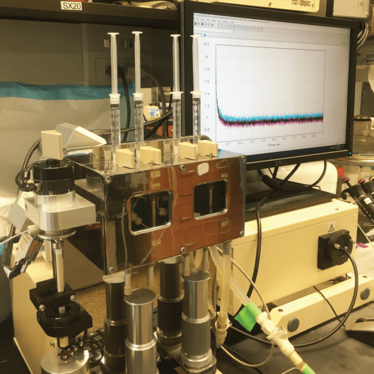Understanding Drug Promiscuity
Some pharmacological side effects are caused by indiscriminate changes to membrane protein function – but is disruption to the lipid bilayer environment or non-specific binding to blame?

Radda Rusinova is an Assistant Professor of Research in Physiology and Biophysics at Weill Cornell Medicine – the biomedical research unit and medical school of Cornell University. There, she examines how drugs can alter the function of membrane-spanning proteins with unwanted and potentially harmful side effects, with a view to casting much-needed light on a significant problem in drug discovery and development. We spoke to Rusinova about the origins, execution, and implications of her work.
Where did your journey as a scientist begin?
I was born in Odessa, Ukraine, and was introduced to science early in life by my mom, who trained and worked as a physicist at the Odessa I I Mechnikov National University. After we relocated to the US, she continued her career as a researcher – now in biophysics and biochemistry – at the Mount Sinai School of Medicine in New York City. My mom was always excited to go to work and talk about what she was studying. Her lab was a place of wonder and collaboration - a place where people pushed their intellectual boundaries.
My mom’s influence stayed with me during my undergraduate studies at Brandeis University, where I decided on a career as a scientist. After getting my BS, I studied for a PhD on ion channel regulation at the same Mount Sinai school of medicine where my mother once worked.
My postdoc was spent with world-renowned lipid bilayer biophysicist Olaf Andersen at Weill Cornell Medicine, where I continue to work today. During my postdoctoral work, we studied the mechanisms by which small amphiphilic molecules can cause drastic changes in bilayer physical properties. In contrast to my PhD thesis, where I demonstrated how specific interactions of ligands change protein function, the research in the Andersen lab was pointing to an entirely different, non-specific mechanism by which drugs can produce changes in protein function.
What questions are you trying to answer?
In short, we want to determine if and how drugs change membrane protein function by altering the lipid bilayer environment. Many drugs have side or off-target effects that complicate their use, but the mechanisms behind these effects are typically unclear. In our lab at WCM, we focus on the fact that many drugs are amphiphilic – meaning that they can interact with lipid bilayers (and cell membranes). These interactions may alter the properties of the bilayer by a little or a lot – and they may explain why drugs’ off-target effects often involve indiscriminate changes in the function of lipid bilayer-spanning proteins (membrane proteins), including receptors and ion channels. In our study (1), we sought to learn whether drugs modify the lipid bilayer environment of these proteins enough to bring about indiscriminate changes in their function.
How did you begin tackling that question?
First, we needed to find a proxy that would represent a prototypical membrane protein, and a functional assay to determine drug effects on the protein and its lipid bilayer environment. We chose the bacterial ion channel KcsA because it is structurally similar to mammalian ion channels, relatively simple to purify, and is not a target for the drugs we selected.
Our opening move was to establish that changes in bilayer thickness alter the function of KcsA by changing the lipid composition of the bilayer into which we inserted it.
Next, we determined whether (and at what concentrations) the selected drugs altered the lipid bilayer’s properties. To this end, we chose another simple bacterial protein that had been developed the Andersen lab to serve as a versatile and robust probe for changes in bilayer properties. We also determined whether (and at what concentrations) the selected drugs directly interacted with KcsA by using isothermal titration calorimetry, which is a powerful method for measuring the strength of drug–protein interactions.
Finally, we tested a group of drugs with a range of clinical off-target effects and physico-chemical properties to characterize what – if any – effects they would have on KcsA, and the concentration at which those effects would occur.

Can you share your results? What can we take away from them?
Changing bilayer thickness changed KcsA function, establishing that KcsA is sensitive to changes in bilayer properties. When we turned our attention to the drugs, we saw that the more they altered the bilayer, the greater their effects on KcsA function. Moreover, the strength of the drugs’ effects on KcsA varied with the bilayer thickness. These results show that drugs may change membrane protein function not only by direct interaction with the protein, but also by modifying the protein’s lipid bilayer environment, thereby providing a mechanism for indiscriminate changes.
In addition, we obtained evidence for direct interactions between some drugs and KcsA, suggesting that their non-specific effects also may be mediated by direct, if non-specific interactions.
The main takeaway is that mechanisms of action responsible for the therapeutic profile of a drug – especially amphiphilic drugs – involve a combination of the drug’s effect on the lipid bilayer, and non-specific direct interactions. Both mechanisms are likely to cause indiscriminate drug-induced changes in the function of multiple membrane proteins that underlie a drug’s off-target effects. With this discovery in mind, we now know that care should be taken to characterize how novel drugs affect the bilayer and – if the need arises – work should be done to fine-tune their physico-chemical profile accordingly.
What challenges remain?
One unticked box is the task of unambiguously separating effects caused by direct interactions from those that are caused by changes to the lipid bilayer.
Moreover, given that the shape and conformational changes of different membrane proteins vary, determining how sensitive other membrane proteins are to changes in lipid bilayer is another such unticked box. The Andersen laboratory has already demonstrated the generality of the bilayer-mediated regulation of membrane protein function, but work still needs to be done.
What are your immediate ambitions?
Next, I wish to determine which protein features – if any – confer sensitivity to changes in bilayer properties. Though all membrane proteins are tightly coupled to the surrounding lipid bilayer, changes in bilayer properties, such as elasticity and curvature, may produce varying effects on different proteins, depending on the conformational changes that underlie their normal function.
We already saw evidence of this when we observed how KcsA functional states varied in their response to the changes in bilayer properties. The reason for this dependence is, in part, the changes at the protein/lipid interface as the protein shifts between functional states. We suspect that the more the interface changes, the more sensitive the protein will be to its lipid environment. But are there specific residues or structural characteristics that confer this sensitivity? Nailing down these causes and effects will be a challenge, but the insights that we glean over time will be important for the future design of more selective drugs.
We must also explore the location of drugs in the lipid bilayer/protein setting. Where do they prefer to stay? In the bulk lipid, where the drug will primarily alter the lipid bilayer contribution to the protein’s conformational preference? Or do they prefer to be bound to a discrete pocket on the protein? Perhaps they gravitate to the interface between the protein and lipid bilayer… We don’t know yet, but we want to find out.
Finally, we hope to develop strategies to assess how a drug’s off-target effects – whether mediated by changes in bilayer properties or non-specific binding – could result in a beneficial or detrimental therapeutic profile.
- R Rusinova et al., “A general mechanism for drug promiscuity: Studies with amiodarone and other antiarrhythmics”, JPG (2021). DOI: 10.1085/jgp.201511470



















